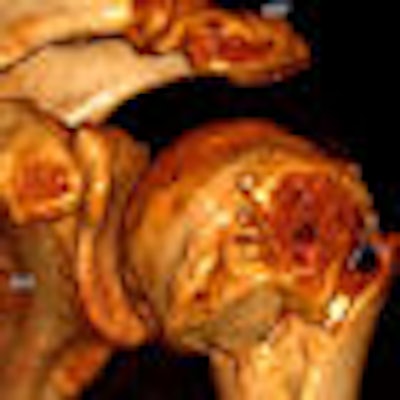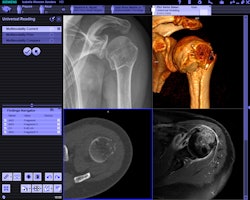
Multimodality vendor Siemens Healthcare of Malvern, PA, is getting a jump on RSNA week by launching a trio of new products -- two new superconducting MRI scanners and a new 3D software platform that represents the company's first foray into client-server enterprise-wide advanced visualization.
Although Siemens has traditionally been known as more of a big-iron vendor than a software developer, the company is putting a special emphasis on syngo via, the new 3D software platform. Via is the product of a major Siemens R&D effort to make advanced visualization more accessible across the healthcare enterprise, "uncaging the beauty" of advanced visualization and making it a primary reading tool, according to Bernd Montag, CEO of the company's Imaging & IT division.
 |
| Syngo via is designed to support primary 3D image interpretation. All images courtesy of Siemens Healthcare. |
While client-server 3D platforms have been available for the past several years, Siemens believes that syngo via is unique in two aspects: its emphasis on support for multimodality images rather than just large multislice CT datasets, and its incorporation of workflow algorithms designed to make the use of 3D more efficient and less time-consuming.
For example, cases like cardiac CT angiography are preprocessed to perform steps like bone removal and artery segmentation prior to delivery to the radiologist. Siemens engineers also developed an improved user interface designed to optimize the image interpretation process, giving radiologists more screen real estate to improve concentration, Montag said. Little mouse interaction is required, which enables radiologists to keep their eyes on images. The software can function as a reporting tool as well.
Syngo via is vendor-neutral and works with any company's images, Montag said, but users of Siemens equipment will be able to take advantage of specialized acquisition and viewing applications, and via's workflow-optimization tools work best when the information is shared with a Siemens modality scanner.
Syngo via will be available commercially in the summer of 2010, and the software is already working at a few beta installations. The platform will be sold independently of a Siemens PACS or other syngo installation, and the company envisions the software being sold in package deals with modality scanners. Montag compared the company's strategy to past models in which a scanner was sold packaged with a workstation -- now, a scanner might come packaged with syngo via.
Sites that already have PACS can install syngo via on top of their existing software, he said.
"Syngo via becomes the vehicle for direct, primary reading," Montag said. "To some extent the PACS is downgraded to the archive and infrastructure piece."
Magnetom Skyra and Aera
Software is all well and good, but no RSNA would be the same without the big iron, and Siemens does not mean to disappointment with Magnetom Skyra and Magnetom Aera, 3-tesla and 1.5-tesla scanners, respectively.
 |
| Magnetom Skyra is a 3-tesla MRI scanner with a 70-cm interior bore diameter. |
"We are now truly a 70-cm company," Montag said. "An open bore is standard at Siemens."
Both scanners also make use of the newest generation of Siemens' Total imaging matrix (Tim) coil and radiofrequency technology, Tim 4G, which is also being rolled out at this year's RSNA meeting. Tim 4G now features a standard configuration of 48 channels, with Aera users able to upgrade to 64 channels and Skyra users able to upgrade to either 64 or 128 channels. All configurations come with 204 coil elements.
Other Tim improvements include a dockable table that enables staff to prepare patients prior to an exam and wheel them into the MRI suite when ready, improving productivity and workflow. In addition, the company's DirectConnect technology eliminates coil cables, enabling them to be plugged directly into the table. Siemens is rolling out DirectConnect with spine, head, and foot and ankle coils.
In addition, Siemens has developed a new software engine designed to work with Tim, Dot (day-optimizing throughput engine), intended to make scanning easier and improve the integration of advanced MRI applications into routine clinical work.
Montag said that at an installation of a prototype version of Dot at a U.K. hospital, the facility was struggling in performing cardiac MRI studies, one of the most complicated MRI procedures. The hospital had 14 technologists on staff, of whom only two were really able to perform the exams. After the implementation of Dot, all the technologists could perform cardiac MRI, and productivity grew by 50%, Montag said.
The first Skyra and Aera systems have already been installed at beta sites, with two operating in Germany and two in the U.S. Regular commercial shipments will begin in April 2010. The scanners do not yet have U.S. Food and Drug Administration clearance and will be shown as works-in-progress at the RSNA show.
By Brian Casey
AuntMinnie.com staff writer
November 24, 2009
Siemens adds Flash CT install, November 19, 2009
Siemens installs first Verio MRI scanner in Texas, November 6, 2009
Candelis/Siemens ink distribution deal, November 4, 2009
Siemens highlights ASTRO updates, November 3, 2009
Siemens installs CT in pediatric hospital, October 29, 2009
Copyright © 2009 AuntMinnie.com



.fFmgij6Hin.png?auto=compress%2Cformat&fit=crop&h=100&q=70&w=100)




.fFmgij6Hin.png?auto=compress%2Cformat&fit=crop&h=167&q=70&w=250)











